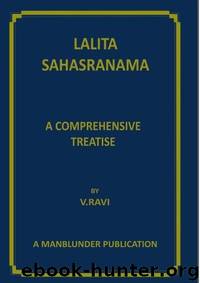LALITA SAHASRANAMA by V RAVI

Author:V RAVI [RAVI, V]
Language: eng
Format: epub, mobi
Publisher: Manblunder publication
Published: 2010-11-22T04:30:00+00:00
INTRODUCTION TO YOGINI-S
From nāma 475 to 534 (60 nāma-s) discuss in detail about the six cakra-s or psychic centres of kuṇḍalinī andsahasrārā. Each cakra or psychic centre is presided over by a deity called yogini and there are seven such yogini-s. The seven cakra-s in the body (considering sahasrāra as a cakra for easier understanding) represent particular body element such as skin, blood, muscle, fat, bone, marrow and semen or egg. Each yoginiis described in 10 or 9 or 7 nāma-s. It is to be clearly understood that these nāma-s are not direct reference toLalitāmbikā. Since Lalitāmbikā is described to be in the form of kuṇḍalinī energy, and the kuṇḍalinī energy has to transcend these cakra-s to reach sahasrāra from mūlādhāra, worshipping the presiding deities of these cakra-s have been undertaken Vāc Devi-s. However, the order of worship neither commences from the base cakra to the crown cakra nor from the crown cakra to the base cakra. It begins with viśuddhi cakra, goes down to the lower cakras then toājñā and ends with sahasrāra. Each of these yogini-s has their own dhyāna verses, japa mantra-s, etc. They have their own assistants and the most important among them is also referred against each of the yogini-s. Their complexion, their armouries, qualities, the food they like, etc have also been described. Sanskrit acoustics has fifty alphabets. All these fifty alphabets are placed in the six cakras. A detailed discussion is provided on the number of Sanskrit alphabets in nāma 833. The order in which they are mentioned in thisSahasranāma is based on two concepts. Each of these yogini-s has many faces. The yogini at viśuddhi cakra has one face and the yogini atsahasrāra has many faces. ProbablyVāc Devi-s could have prioritized these yogini-s based on the number their faces. Alternatively, Vāc Devi-s could have chosen this order based on the type of bodily element, each of these yogini-s represent. First, we have skin followed by blood, muscle and other elements one below the other. The food that we consume is literally cooked by the internal fire in our stomach called jadarāgni. This ‘cooked food’ undergoes suitable changes, modifications and conversions and infused to the respective bodily elements and the finest essence of all is converted into semen and eggs (they are sometimes wrongly interpreted as ojas) that are capable of reproduction. Bhavanopaniṣad (verse 4) says that father of these elements is goddessVārāhī(nāma 70) and mother is goddess Kurukullā(nāma 438).
Sanskrit has fifty alphabets that are divided into sixteen vowels known as ‘letters of life’ (verbatim translation) and the balance is called ‘letters of body’. Each cakra has certain number of lotus petals and each of these petals represent a particular alphabet of Sanskrit. For example, the throat cakra orviśuddhi cakra has sixteen lotus petals, which represent sixteen vowels. The explanation provided here is nothing to do with kuṇḍalinī meditation. What we are going to discuss is concerned about the presiding deity of each cakra and related narrations. It has already been discussed that Her subtlest form is kuṇḍalinī.
Download
This site does not store any files on its server. We only index and link to content provided by other sites. Please contact the content providers to delete copyright contents if any and email us, we'll remove relevant links or contents immediately.
| Chakras | Gandhi |
| History | Rituals & Practice |
| Sacred Writings | Sutras |
| Theology |
Fingersmith by Sarah Waters(2483)
Kundalini by Gopi Krishna(2136)
Wheels of Life by Anodea Judith(2096)
Indian Mythology by Devdutt Pattanaik(1898)
The Bhagavad Gita by Bibek Debroy(1897)
The Yoga of Jesus: Understanding the Hidden Teachings of the Gospels by Paramahansa Yogananda(1803)
Autobiography of a Yogi (Complete Edition) by Yogananda Paramahansa(1774)
The Man from the Egg by Sudha Murty(1743)
The Book of Secrets: 112 Meditations to Discover the Mystery Within by Osho(1628)
Chakra Mantra Magick by Kadmon Baal(1616)
The Sparsholt Affair by Alan Hollinghurst(1545)
Sparks of Divinity by B. K. S. Iyengar(1491)
Gandhi by Ramachandra Guha(1486)
Avatar of Night by Tal Brooke(1484)
Karma-Yoga and Bhakti-Yoga by Swami Vivekananda(1467)
The Bhagavad Gita (Classics of Indian Spirituality) by Eknath Easwaran(1452)
The Spiritual Teaching of Ramana Maharshi by Ramana Maharshi(1401)
Hinduism: A Very Short Introduction (Very Short Introductions) by Knott Kim(1344)
Skanda Purana (Great Epics of India: Puranas Book 13) by Bibek Debroy & Dipavali Debroy(1338)
